Task-dependent changes in short-term memory in the prefrontal cortex
- PMID: 21106819
- PMCID: PMC3082458
- DOI: 10.1523/JNEUROSCI.1569-10.2010
Task-dependent changes in short-term memory in the prefrontal cortex
Abstract
The prefrontal cortex (PFC) is important for flexible, context-dependent behavioral control. It also plays a critical role in short-term memory maintenance. Though many studies have investigated these functions independently, it is unclear how these two very different processes are realized by a single brain area. To address this, we trained two monkeys on two variants of an object sequence memory task. These tasks had the same memory requirements but differed in how information was read out and used. For the "recognition" task, the monkeys had to remember two sequentially presented objects and then release a bar when a matching sequence was recognized. For the "recall" task, the monkeys had to remember the same sequence of objects but were instead required to recall the sequence and reproduce it with saccadic eye movements when presented with an array of objects. After training, we recorded the activity of PFC neurons during task performance. We recorded 222 neurons during the recognition task, 177 neurons during the recall task, and 248 neurons during the switching task (interleaved blocks of recognition and recall). Task context had a profound influence on neural selectivity for objects. During the recall task, the first object was encoded more strongly than the second object, while during the recognition task, the second object was encoded more strongly. In addition, most of the neurons encoded both the task and the objects, evidence for a single population responsible for these two critical prefrontal functions.
Figures
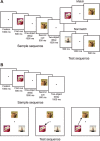
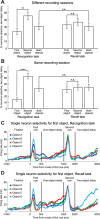
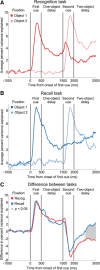

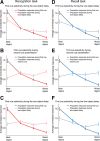

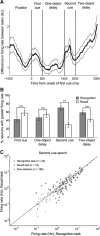

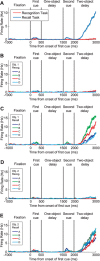
References
-
- Asaad WF, Rainer G, Miller EK. Task-specific neural activity in the primate prefrontal cortex. J Neurophysiol. 2000;84:451–459. - PubMed
-
- Brown J. Some tests of the decay theory of immediate memory. Q J Exp Psychol. 1958;10:12–21.
-
- Cabeza R, Kapur S, Craik FIM, McIntosh AR, Houle S, Tulving E. Functional neuroanatomy of recall and recognition: a PET study of episodic memory. J Cogn Neurosci. 1997;9:254–265. - PubMed
-
- Delbecq-Derouesné J, Beauvois MF, Shallice T. Preserved recall versus impaired recognition. A case study. Brain. 1990;113:1045–1074. - PubMed
Publication types
MeSH terms
Grants and funding
LinkOut - more resources
Full Text Sources
Miscellaneous
